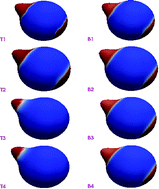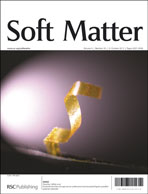Domain formation on curved membranes: phase separation or Turing patterns?†
Abstract
We study by computer simulations the physics of domain formation on surfaces, as a model for pattern formation on biological membranes. We compare the dynamics predicted by a simple phase separation model for a binary mixture, with that obtained through a conserved Turing-like reaction–diffusion model. Both types of models have been proposed as frameworks for understanding the formation of domains in biological systems. Our main result is that the models can be qualitatively distinguished by analysing the competition dynamics which is set when initialising the system with a number of potential pattern-forming nuclei. Our simulations also suggest that the location of the steady state domains is not uniquely determined by the curvature. This lack of curvature dependence might be advantageous biologically, as it disentangles pattern formation from the mechanics and morphology of the cell membranes. We hope our study will stimulate further experimental work on pattern formation in cells, especially in relation to the cell polarisation problem.


 Please wait while we load your content...
Please wait while we load your content...